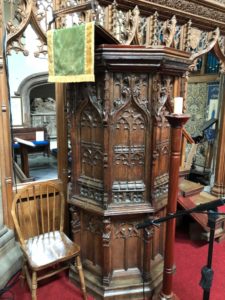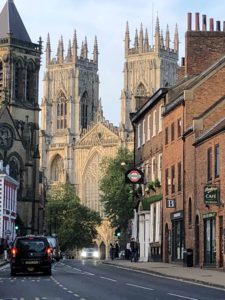
Today we said goodbye to the Old Parsonage Hotel.
Our first stop of the day was St. Mary’s church in Lutterworth, where John Wycliffe was pastor from 1374 until his death in 1384.
As we neared Lutterworth, an ambulance sped by us on the outside lane, I immediately changed lanes to get around the slower car in front of me and began following the ambulance.
Dr. H did not hesitate, “Is that just a natural reflex to chase after ambulances?” Lawyer jokes had worn thin on me years ago, but this one was delivered with such skill even the hardest of barristers would have appreciated it.
We arrived at St. Mary’s church just after noon, not realizing the visiting hours were 10a-12p.
By the grace of God though, a kind man answered the door and allowed us in to look around.
What was found inside was amazing: Wycliffe’s 600 year-old pulpit, his chair, the baptismal font he had used, and a facsimile of his English translation of the Bible. Mrs. H pointed out that interspersed amongst this priceless artifacts was modern furniture used for their current congregation’s children-church, and adult church services. Perfect; not a museum but a living, breathing, functioning church.

I was also reminded of the sovereignty of God. Wycliffe probably thought his career and usefulness to God had ceased when he was exiled by the Catholic Church to Lutterworth, but it was in that quiet place he found the time to complete the one task that would change the world and for which he would forever be remembered: the first translation of the Bible into English. Dr. H reminded me that Luther had suffered a similar exile to Warburg where he translated the Bible in to German. Tyndale would translate the New Testament from Greek into English while in exile in Antwerp.
Wycliffe died in Lutterworth on December 31, 1384, as a result of stroke. He was buried in Lutterworth, and there he lay until 1428. In 1415 at the Council of Constance, the Catholic Church declared Wycliffe a heretic and ordered his bones exhumed and burned. Thirteen years later Wycliffe’s bones were exhumed and his ashes thrown into the River Swift under the bridge over which the A26 now runs. On the way out of Lutterworth, we stopped by the bridge.
From Lutterworth we headed north to Epworth, to the Old Rectory, which is the house where John and Charles Wesley were raised. We enjoyed an hour-long tour through the house, learning about the early years of the brothers Wesley. Our hearts were strangely warmed.
We then hopped back in our very large Mercedes vanbus and continued the journey north.
There was a lot of driving today, and there was bound to be some wrong turns. When those wrong turns were made and the gals began to give directions from the backseat, Dr. H reminded them of the importance of leadership and their submission to it. I thought he handled the situation well.
Around 7:00 p.m. we finally arrived in York. After dinner we walked up the street to York Minister Cathedral. The cathedral presides majestically over the modest skyline of York. It was breathtaking, as I am sure its builders intended.
When we walked around the cathedral we found a statue of Constantine the Great. And about ten feet away there was a plaque indicating this was where Constantine was proclaimed emperor in 306 A.D.. Six years later, Constantine, back in Rome, had his miraculous encounter with God at the Milvian Bridge, converted to Christian, and changed the course of history.
If there was any theme today it was that like York Minster Cathedral presides over York, God presides over history, and He shapes it through those who give themselves fully to Him. GS
